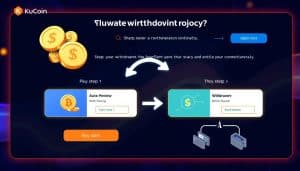Looking to make serious gains in the world of cryptocurrencies? Look no further! This article will show you how to stake your way to crypto riches in 2024. With the right strategy, you can maximize rewards and earn passive income through staking. Explore top cryptocurrencies for staking like Ethereum, Cardano, Tezos, Solana, and Polkadot, and learn how to choose the best option for you. Whether you want to be a validator or a delegator, discover the pros and cons of each approach. Let’s dive into the world of crypto staking and unlock financial success.
Table of Contents
ToggleHow to Pick a Crypto to Stake
To pick a crypto to stake, consider the available PoS cryptocurrencies and research alternative ones for potentially higher returns. Look into options like Ethereum, Cardano, Tezos, Cosmos, and more. Evaluate the total value locked and the network popularity to estimate potential returns. Decide whether you want to be a validator or a delegator, keeping in mind that validators tend to earn slightly more by running a node. Take note of any limitations such as minimum deposits or lock-up periods and explore staking platforms that can simplify the process. For the highest rewards in 2024, Ethereum offers a 2.48% APR with a 32 ETH deposit, while Cardano provides a 4.96% APR with a 2 ADA refundable fee. Tezos offers a 5.89% APR with a 6,000 XTZ deposit, Solana offers a 7.58% APR with a 0.01 SOL deposit, and Polkadot offers a 15.31% APR with a 350 DOT deposit. Keep in mind that other top crypto coins like Polygon, Avalanche, Cosmos, Algorand, and Near Protocol also offer attractive staking options.
Consider Available PoS Cryptocurrencies
When considering available PoS cryptocurrencies, you need to explore options like Ethereum, Cardano, Tezos, Cosmos, and more. These cryptocurrencies implement the Proof of Stake (PoS) consensus mechanism, which allows users to stake their coins and earn rewards. Ethereum, with a 2.48% annual percentage rate (APR) and a minimum deposit of 32 ETH, is a popular choice for staking. Cardano, with a 4.96% APR and a 2 ADA refundable fee, offers attractive rewards as well. Tezos boasts a 5.89% APR and a 6,000 XTZ deposit requirement. Other options include Cosmos, with a high APR of 25.17%, and Solana, with a competitive 7.58% APR. By carefully considering the available PoS cryptocurrencies, you can maximize your potential for crypto riches in 2024.
Research Alternative PoS Cryptocurrencies
Explore other PoS cryptocurrencies as alternatives to maximize your staking rewards in 2024. While Ethereum, Cardano, Tezos, Solana, and Polkadot may be popular choices, it is crucial to consider alternative options that could potentially offer higher returns. Researching alternative PoS cryptocurrencies is essential, as these may have fewer active validators, increasing the likelihood of higher rewards. When evaluating these alternatives, estimate the return based on factors such as total value locked and network popularity. Additionally, consider the options of being a validator or a delegator, with validators earning slightly more by running a node. However, be mindful of any limitations, such as minimum deposits or lock-up periods, and take advantage of staking platforms to simplify the staking process. By exploring these alternative PoS cryptocurrencies, you can potentially enhance your staking rewards in 2024.
Estimate Return Based on Value Locked
Estimate the return on your staking investment by considering the value locked in the network. The value locked, also known as total value locked (TVL), is a crucial metric that indicates the amount of cryptocurrency being staked in a particular network. It is a measure of the network’s popularity and the confidence users have in it. By analyzing the TVL, you can gain insights into the potential returns you can expect from staking your crypto assets. Networks with higher TVL tend to offer more stable and predictable returns due to increased network security and participation. However, it’s important to note that the actual return on your staking investment may vary depending on factors such as network inflation, compound interest, and the specific staking mechanism employed by the network. Therefore, it’s essential to thoroughly analyze the TVL and other relevant factors before making your staking investment decision.
Choose Between Validator or Delegator
To make the most of your staking investment, consider whether you want to be a validator or a delegator. Validators earn slightly more by running a node and have more control over the staking process. However, being a validator requires a higher minimum deposit, such as 32 ETH for Ethereum. On the other hand, delegators do not need to run a node but instead trust a node provider to handle the staking process. Delegating is a more accessible option for those with smaller investments or less technical expertise. Additionally, delegators can participate in staking pools or use centralized exchanges for staking, which offer convenience but come with their own set of risks and fees. Ultimately, the choice between being a validator or a delegator depends on your investment goals, technical capabilities, and risk tolerance.
Be Aware of Limitations and Use Staking Platforms
To maximize your staking experience and overcome potential limitations, it is important to be aware of certain factors and consider utilizing staking platforms. Here are a few things to keep in mind:
- Understand the limitations: Be aware of any minimum deposit requirements or lock-up periods associated with staking. These limitations can vary depending on the cryptocurrency you choose to stake.
- Use staking platforms: Consider using staking platforms like Lido or Rocket Pool, which offer simplified staking options and liquidity for your staked assets. These platforms can provide a more user-friendly experience and help you manage your staked assets effectively.
Best Cryptos for Highest Rewards in 2024
Discover the best cryptocurrencies for achieving the highest rewards in 2024. When it comes to staking, Ethereum offers an estimated 2.48% APR, with a minimum deposit of 32 ETH. Cardano, on the other hand, provides a 4.96% APR, with a refundable fee of 2 ADA and a total value of 24,506,909,293 ADA. Tezos offers a 5.89% APR, requiring a 6,000 XTZ deposit. Solana boasts a 7.58% APR, with a minimum deposit of 0.01 SOL. For those seeking higher rewards, Polkadot offers a 15.31% APR, with a deposit requirement of 350 DOT. Other notable options include Polygon with an 8.61% APR, Avalanche with a 9.51% APR, Cosmos with a 25.17% APR, Algorand with a 7.2% APR, and Near Protocol with a 9.89% APR. Consider these cryptocurrencies and their respective staking options to maximize your rewards in 2024.
Ethereum: APR, ETH, Deposit
When staking Ethereum in 2024, you can expect an estimated APR of 2.48%, a minimum deposit requirement of 32 ETH, and the option to choose between being a validator or delegator. Here are some important considerations for staking Ethereum:
- Validators earn an estimated 2.48% APR, while delegators earn an estimated 2.25% APR.
- Staking pools like Lido or Rocket Pool offer higher APRs ranging from 4.04% to 7.09%.
- Centralized exchanges claim around 4% APY for Ethereum staking.
- Solo staking as a validator requires a minimum deposit of 32 ETH, while delegating doesn’t require running a node but involves trusting a node provider.
- Pooled staking protocols like Lido or Rocket Pool allow staking with as little as 0.01 ETH and offer liquidity.
- Centralized staking on platforms like Binance, Kraken, or Coinbase is easy but comes with fees and custody risks.
Cardano: APR, ADA, Refundable Fee
For Cardano, you can expect an APR of 4.96%, a total supply of 24,506,909,293 ADA, and a refundable fee of 2 ADA. Cardano is a promising cryptocurrency for staking in 2024, offering a competitive APR and a large supply of ADA tokens. With a refundable fee of only 2 ADA, it is accessible for users looking to stake their ADA coins and earn rewards. To provide a clearer picture of Cardano’s staking potential, here is a table summarizing key details:
| Cardano Staking | ||
|---|---|---|
| Annual Percentage Rate (APR) | Total Supply (ADA) | Refundable Fee (ADA) |
| 4.96% | 24,506,909,293 | 2 |
With these figures, Cardano offers a compelling opportunity for investors to stake their ADA tokens and potentially earn attractive returns.
Tezos: APR, XTZ, Deposit
To stake Tezos in 2024, you will need to consider the Annual Percentage Rate (APR), the amount of XTZ required for the deposit, and the different staking options available. Tezos currently offers an APR of 5.89%, making it an attractive choice for stakers seeking higher returns. To stake Tezos, you will need to deposit a minimum of 6,000 XTZ. There are several staking options available for Tezos, including baking as a solo validator, delegating XTZ to a baker, and participating in staking via exchanges or staking platforms. Each option has its own advantages and considerations, so it’s important to research and choose the one that best suits your preferences and risk tolerance.
- Baking as a solo validator
- Requires technical knowledge and running a node
- Offers higher potential rewards
- Delegating XTZ to a baker
- Does not require running a node
- Relies on trusted bakers for rewards distribution
Solana: APR, SOL, Deposit
To stake Solana in 2024, you will need to consider the Annual Percentage Rate (APR), the amount of SOL required for the deposit, and the various staking options available. Solana offers a competitive APR of 7.58%, making it an attractive choice for stakers looking for higher returns. The minimum deposit required to stake SOL is just 0.01 SOL, making it accessible for a wide range of investors. Whether you choose to stake as a validator or a delegator, Solana provides options that suit your preferences and risk tolerance. Staking platforms and exchanges may also offer simplified staking options, providing additional flexibility to stakers. Consider these factors when deciding to stake Solana and maximize your potential crypto riches.
| APR | SOL | Deposit |
|---|---|---|
| 7.58% | 386,591,630 | 0.01 SOL |
Polkadot: APR, DOT, Deposit
Continuing with our exploration of staking options for potential crypto riches in 2024, let’s now turn our attention to Polkadot and delve into its APR, DOT, and deposit requirements.
- APR:
- Polkadot offers an attractive APR of 15.31%.
- This high annual percentage rate makes Polkadot one of the most lucrative staking options in our list.
- DOT:
- With a total supply of 610,865,947 DOT, Polkadot presents a substantial staking opportunity.
- The abundance of DOT tokens ensures that there is a significant amount available for staking, allowing users to potentially earn substantial rewards.
- Deposit:
- To participate in Polkadot staking, a minimum deposit of 350 DOT is required.
- This deposit requirement ensures that participants have a vested interest in the network’s security and stability.
Other Top Crypto Coins to Stake in 2024
As we explore the potential crypto riches of staking, let’s now turn our attention to the other top crypto coins that you can stake in 2024. Here are some of the top crypto coins to consider:
| Crypto Coin | Annual Percentage Rate (APR) | Total Supply |
|---|---|---|
| Polygon | 8.61% | 3,626,203,374 |
| Avalanche | 9.51% | 230,725,275 |
| Cosmos | 25.17% | 222,656,867 |
Polygon offers an APR of 8.61% with a total supply of 3,626,203,374 tokens. Avalanche provides an APR of 9.51% with a total supply of 230,725,275 tokens. Cosmos, on the other hand, offers a significantly higher APR of 25.17% with a total supply of 222,656,867 tokens. These crypto coins present enticing staking opportunities for potential investors looking to earn passive income in the crypto space.
Factors to Consider When Staking Ethereum
When staking Ethereum, there are several factors to consider before making your investment decision:
- Decentralization: Evaluate the level of decentralization of the Ethereum network and the number of active validators. A more decentralized network is generally considered more secure and resistant to attacks.
- Rewards: Understand the potential rewards for validators and delegators. Validators can earn an estimated 2.48% APR, while delegators earn around 2.25% APR. Staking pools like Lido or Rocket Pool offer higher returns ranging from 4.04% to 7.09% APR.
These factors are crucial in determining the profitability and security of your Ethereum staking venture. By considering decentralization and potential rewards, you can make an informed decision about whether to stake Ethereum as a validator or delegator and choose the most suitable staking platform or protocol. Remember, always conduct thorough research and assess the risks before staking your Ethereum.
Staking Options for Cardano, Tezos, Solana, and Polkadot
To explore the staking options for Cardano, Tezos, Solana, and Polkadot, consider the available opportunities for earning passive income through validating or delegating your cryptocurrencies. For Cardano, you can stake ADA by either staking with a full node wallet or delegating ADA to participate in staking. Tezos offers two options: baking as a solo validator or delegating XTZ to a baker. Solana requires a minimum deposit of 0.01 SOL for staking and allows both validators and delegators to participate. Polkadot, on the other hand, requires a minimum deposit of 350 DOT and allows both validators and nominators to stake. Staking platforms and exchanges may offer simplified staking options for all these cryptocurrencies, providing you with various choices to earn passive income.
Frequently Asked Questions
What Is the Minimum Deposit Required for Staking Ethereum as a Solo Validator?
To stake Ethereum as a solo validator, you’ll need a minimum deposit of 32 ETH. This allows you to participate in the network and earn estimated rewards of 2.48% APR.
What Are the Staking Options for Cardano?
To stake Cardano, you can choose to stake with a full node wallet, delegate ADA to participate in staking, or opt for centralized staking options. Explore these options to make the most of your Cardano investment.
What Is the Annual Percentage Rate (Apr) for Staking Tezos?
The annual percentage rate (APR) for staking Tezos is 5.89%. Consider staking as a solo validator or delegating XTZ to a baker. Exchanges and staking platforms also offer staking options for Tezos.
What Is the Minimum Deposit Required for Staking Solana?
To stake Solana, you’ll need a minimum deposit of 0.01 SOL. As a validator or delegator, you can participate in staking. Staking platforms and exchanges may offer simplified staking options for your convenience.
What Are the Staking Options for Polkadot?
To stake Polkadot, you have two options: become a validator or a nominator. Validators require a minimum deposit of 350 DOT, while nominators can participate with smaller amounts. Staking platforms and exchanges may offer staking services.





















